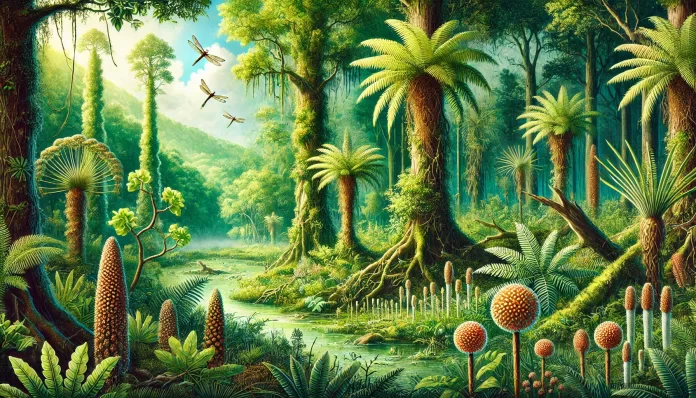Chapter 2: The Rise of the Forests
As plants continued their conquest of land, they began to reshape Earth’s landscapes on a grand scale. From the small, mossy carpets of the early bryophytes came towering forests, vast and green, that transformed the atmosphere, climate, and ecosystems forever. This chapter of plant history, spanning hundreds of millions of years, saw the rise of trees, the formation of Earth’s first great forests, and the birth of the carbon cycle.
The Devonian Explosion (419–359 Million Years Ago)
The Devonian Period is often called the “Age of Plants” because it was during this time that plants diversified and grew to dominate terrestrial landscapes. By this period, vascular plants had evolved roots, stems, and leaves, which allowed them to grow larger and more complex. Key innovations included:
- Roots: These anchored plants to the ground and allowed them to absorb water and nutrients more efficiently.
- Leaves: Broad, flat leaves like those of Archaeopteris maximized the capture of sunlight, boosting photosynthesis.
- Lignin: A strong, woody substance in cell walls gave plants the structural support to grow taller and outcompete their neighbors for sunlight.
The first true trees, such as Archaeopteris, emerged during this time. These ancient ancestors of modern conifers and ferns formed Earth’s first forests, creating dense, green habitats that provided shade, stabilized soils, and influenced the global climate.
The Carboniferous Coal Age (359–299 Million Years Ago)
The Carboniferous Period marked the zenith of ancient forests. Swampy wetlands were dominated by vast forests of giant lycophytes (Lepidodendron), horsetails (Calamites), and seed ferns. These plants thrived in warm, humid conditions, and their immense size was made possible by the high oxygen levels of the time.
As these plants died, they fell into waterlogged swamps, where low oxygen levels slowed decomposition. Over millions of years, their remains were compressed and transformed into the coal deposits we use today. This process sequestered massive amounts of carbon, dramatically reducing atmospheric CO₂ levels and contributing to a cooling climate.
Seeds: A Revolutionary Adaptation
One of the most critical developments during this era was the evolution of seeds. Unlike spores, which required moist environments to germinate, seeds contained their own food supply and protective coating, allowing plants to colonize drier and more diverse habitats. Early seed plants, such as gymnosperms (ancestors of modern conifers, cycads, and ginkgo), began to outcompete spore-bearing plants.
Seeds were a game-changer. They allowed plants to spread across continents, survive harsh conditions, and establish in areas previously inhospitable to life.
The End of the Ancient Forests
By the end of the Carboniferous, Earth underwent significant climatic shifts. The lush, tropical forests of the period gave way to drier climates during the Permian Period. Many of the giant lycophytes and horsetails that had dominated for millions of years went extinct, making way for the rise of gymnosperms.
But the legacy of these ancient forests lived on. Their remains formed the coal beds that powered the Industrial Revolution and continue to shape modern society.
A Green Foundation for Animal Life
The forests of the Devonian and Carboniferous not only transformed the atmosphere by pumping out oxygen but also laid the groundwork for terrestrial animal life. Insects, amphibians, and early reptiles found shelter, food, and new ecological niches within these forests.
With each evolutionary leap, plants were creating a more interconnected and vibrant biosphere. But the story of plants was far from over. The next chapter sees the rise of an even more extraordinary innovation: the flower.




